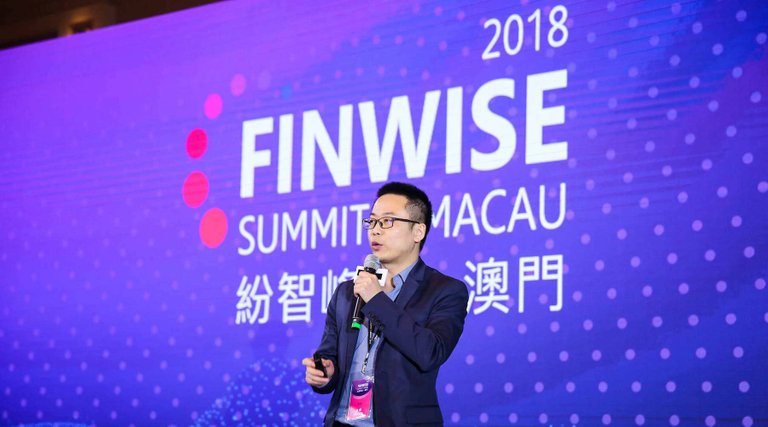
Good afternoon! I’m the CTO responsible for Metaverse, Chen Hao. Today, I’ll only be talking about three issues: what is wrong with the current Internet, how blockchain can be assimilated by the Internet, and how Metaverse will implement this assimilation. Let’s jump right into it.
I believe that everyone here has heard about, if you follow news about personal data security, the Alipay scandal where the app would turn on a user’s phone mic and camera periodically to secretly take photos and sound recordings on Android devices. Although there has been no evidence, some engineers have been able to indirectly prove that the Alipay app does have the ability to periodically take photos and sound recordings on Android devices.
On Children’s Day (1 June) in 2016, Alipay also added the suffix “baby” to each user’s nickname without their approval – I believe everyone should remember this incident as well. Although some younger users may think that it’s not a big deal or that it’s fun, more serious users including myself view Alipay’s actions as unacceptable. Why? It’s simple - because the right to use the nickname belongs to me, so why should Alipay unilaterally decide to change it? Even though it was a marketing stunt, we can draw certain conclusions.
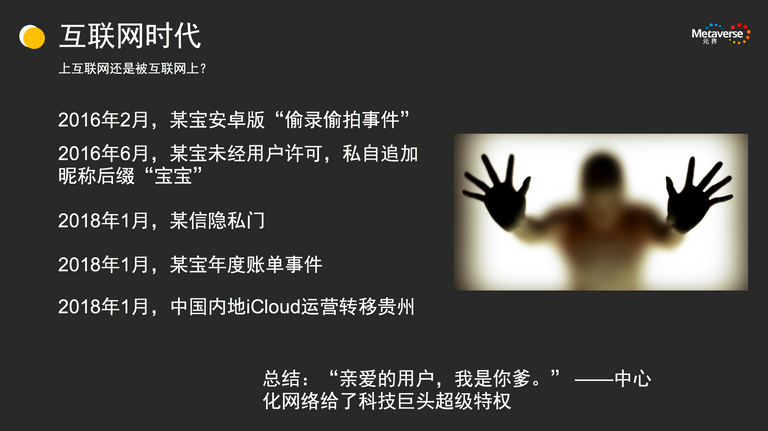
Recently, WeChat implemented a privacy policy update, but this news was buried by another incident: Alipay’s Annual User Footprint Report. Again, everyone should have heard about this issue. Before viewing the report, the landing page contained a checkbox in extremely small print that allowed users to opt into the Sesame Credit scoring service that was ticked by default. This blew up into a huge PR issue with a heavy price for Alipay, which had to release multiple press statements.
Looking at these events, we can infer a few other points. For example, if we talk about the last piece of news, (note: he refers to the last point on his PowerPoint slide, about Apple outsourcing its Chinese iCloud operations to a Guizhou-based Chinese firm) everyone should be able to understand what it really means: that Apple has given up on Chinese users, and that your data has come back. Everyone should be aware that China’s Internet is less protective of an individual’s personal data, or should we say that this concept doesn’t exist at all? Plus extreme uses of the Internet, we can conclude that most people now just ridicule these things and accept that Big Brother is Watching You. Other compulsory “experiences” such as Android devices compelling you to authorize some function or the other in order to use an app are also very common. Why is this so?
It’s simple: when you’ve used a centralized service and given it certain privileges, does your data belong to you or to the service? When the service uses your data, it’s often without your permission. I believe no one has ever received a request for permission saying that the service will be using your behavioral data for Big Data analysis, right? Then, let us look at what the Internet is working on now. The winds of change have arrived for blockchain technology – 2017 was the year where cryptocurrencies became red-hot, but only within crypto circles. What will 2018 bring? The Internet’s standing army has arrived. A wave of internet companies is exploring blockchain initiatives and how they can integrate their operations with blockchain. For example, Renren Inc. or Xunlei, both lower-tier internet companies, are already trying to capitalize on blockchain integration. Big companies are also trying, although not as abruptly, producing small technical or use-case proof-of-concepts in the case of NetEase. As we move from the Internet era to the Blockchain era, can current Internet technologies continue to dominate? Different people will view this differently, and I trust everyone has their own perspective, so I won’t elaborate on mine.
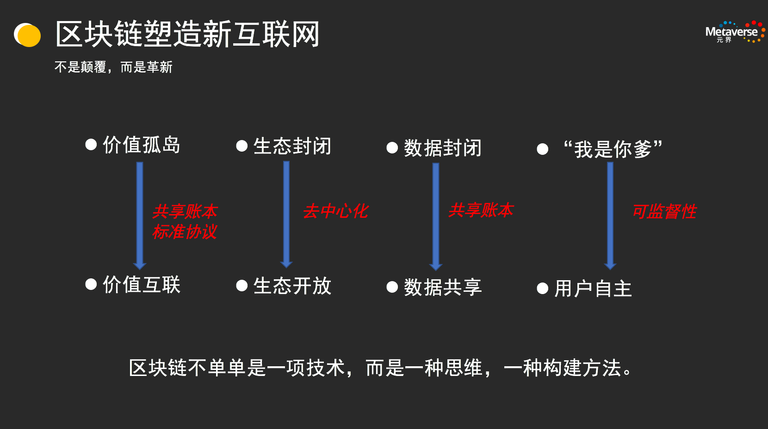
With that, how will blockchains model the new Internet? This is a more serious topic; when we discuss the current Internet, we speak in more abstract terms. I usually pick a label without much thought: “islands of value”, “sealed-off ecosystem”, “sealed-off data”, “Big Brother is watching”. Below (referring to the slides) are some features that blockchains can bring; after listening to so many presentations everyone should be familiar with things like decentralization and openness. These are more general features, so I won’t explain further, and they’re mostly realized through shared ledgers, standard protocols and decentralization. However, these are just technical features, or should we say just one aspect. What will truly bring change is not merely technology, but an update – blockchains are a new way of thinking. But now, everyone talks about tokenization or digitization rather than how blockchain decentralization affects the product. As such, blockchains are not just a type of technology, but a way of thinking, a new way to build that combines technical and structural innovation.
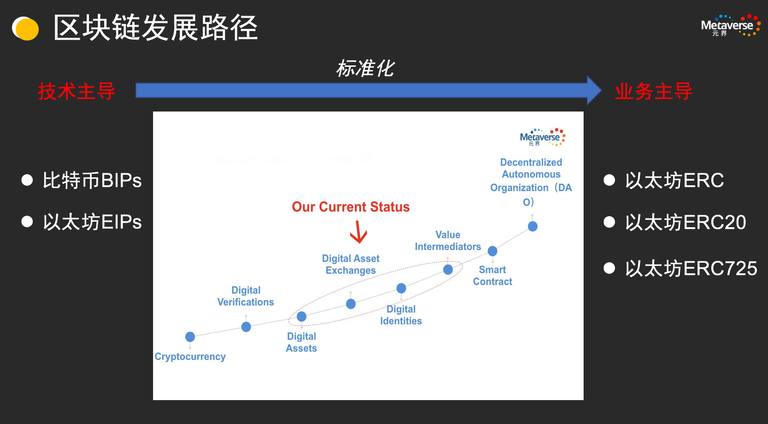
In the past, we were usually guided by technology, but I feel that the community has changed and is beginning to be led by industries. This figure (shown below) is our original roadmap, and was already present in the initial version of our white paper. We feel that blockchain development will follow the path shown in the roadmap, beginning from cryptocurrencies, then moving on to digital verifications and assets, tokenized and digitized assets, trading, then value intermediaries. Within the community, I feel that we have already reached this point. Going further, we reach the concept of DAOs covered by Professor Wang yesterday. But that’s far into the future; let’s talk about the present. This sort of roadmap used to be written by developers. How can you tell?
Bitcoin has an interesting concept called BIPs, while Ethereum has EIPs. Both of them target developers and engineers – you raise a proposal and submit some research. However, I’ve found that these concepts aren’t popular because they’re difficult to understand and very underwhelming when explained. Something the majority can understand is called ERC, which most should have heard of. I’ll be covering how the names ERC, ERC20 and ERC725 came about later. Has anyone heard of 725? If not, I’ll talk about it later.
Going back to the process of moving from being technically-guided to being industry-guided that I previously mentioned: how should we go about it? China has a project called Maverick Chain that provides Blockchain-as-a-Service (BaaS), a concept introduced by us. Do we really care if a blockchain or some blockchain application is centralized or decentralized? Often, this isn’t our first concern – our first concern is whether it will moon, whether it can solve my problems. If I want to view its price, I don’t care if the price data comes from a centralized or decentralized source. From this, we can see that sometimes solving my problem is my main motivation. To this end, we came up with a solution called BaaS, allowing one to raise their productivity through technical solutions. This figure (shown below) is how I view the structure of the current Internet. Say for example that you use some services from Tencent, Alibaba and Baidu. Each of these services are based on an ecosystem, which allows me to use a QQ account to log into all Tencent applications or a Baidu account to log into all Baidu applications, but I’ll never be able to log into a Tencent application with a Baidu account. Hence, I termed these “islands of value”, in other words information silos.
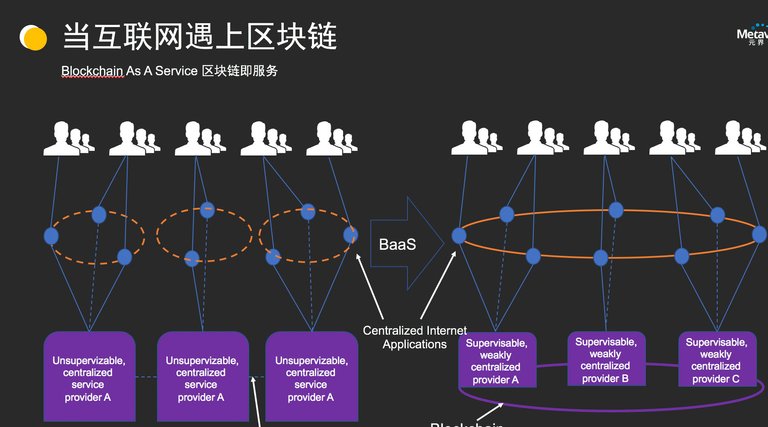
What results can we achieve through BaaS? How can these silos be linked together? You can see that we can get rid of all the underlying weirdos, and just need one blockchain on which services can be built. Then, centralized or decentralized applications can be freely built on top of the blockchain. Speaking from a technical point of view, I feel that this is a key development for the future. Through BaaS, we can “blockchainize” the current Internet and build an Internet of value that lends itself to supervision. All applications developed will be centralized applications that can be supervised.
As I promised, back to talking about ERC. Does anyone know what the term ERC means or where it comes from? In the early days of the internet, there was a concept called RFC (Request for Comments). Devs should know that RFC is a set of standards for internet protocols, or a set of drafts raised by experts and specialists, allowing some protocols to be specified for the internet. After these protocols become standard, everyone builds new functions and applications on top of them. What does this mean? In other words, to simplify connection to Ethereum, they built standards based on the Ethereum blockchain.
How did ERC20 come about? Has anyone thought about this before – why did ERC20 become so popular? I’d like to ask if anyone has ever heard of ERC190? Right, nobody. Who cares about smart contract packaging specifications? How about ERC 545? I admit, I don’t know that one either because I can’t recall it right now.
The commercial disruption brought about by tokenization is easy to accept and to understand, as opposed to packaging specifications which aren’t meant for general use. ERC20 is actually just a type of contract. If I write a smart contract on Ethereum to generate tokens, these tokens are based on the Ethereum blockchain and all that is required is an API and a press of a button. If we visualize the process, all I need to do is drag and drop to issue a token, improving Ethereum’s user experience. ERC725 is a specification for digital identities on Ethereum. The effect is that developers now do not need to write their own code; they just need to pick out what they need from the existing toolkit. So why do we need ERC20? The answer is simple – it standardizes contracts, making them generally applicable and available for widespread use.
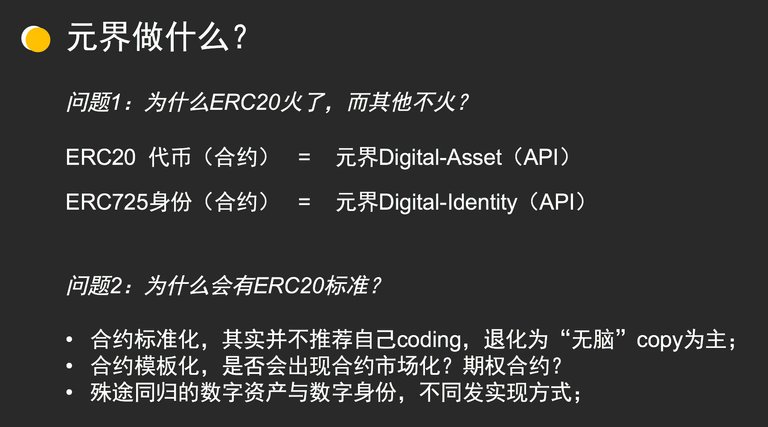
Ethereum doesn’t recommend all users to go and write code or smart contracts, since this would result in problems and bugs. If the problematic code is copied by others, the bug remains. The situation has degenerated into a state where copying is rampant and users ignore what the smart contract does as long as the function they need can run. This then is one of our beliefs: users should be able to get what they need directly from a toolkit. Contracts of the future will be standardized and marketized. Some professional contracts are inevitable, such as options contracts. Although Ethereum currently lacks this, I believe they will be developed in the future. However, we first need an exchange, and this will have to be created by users themselves. As for some general functions, we simply need to implement them within the technology’s infrastructure. All roads lead to Rome – I believe that we are moving towards the same goal as Ethereum, although we use different digital identity and digital asset implementations. Because these two are core features in a blockchain, they’re also extremely important.
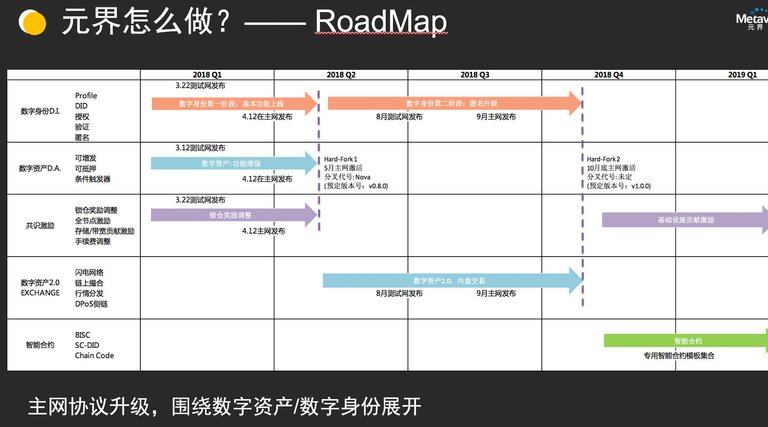
This is a roadmap for Metaverse’s development in 2018 (referring to the slides, diagram below). We will be integrating more functions, including the first phase of our digital identity implementation. Additionally, we’re strengthening digital asset features so users will have the ability to issue additional supply or recall some of their asset’s supply. Let us know what tools you need, and we’ll do our best to provide it for you so that users don’t have to worry about how the code is written. I can assure you that full decentralization is not a problem, the blockchain is immutable, and the code is fully open-source. Interested parties may review the code; uninterested parties, the code works.
We will also be introducing some new anonymity features. All our upgrades are centered around the expansion of the two key digital identity and digital asset features mentioned previously. In the case of anonymity, it is closer to the architecture model of the traditional internet and has been covered by other speakers. However, I believe no one else has mentioned cloud service integration. My background is in software architecture engineering, so I can safely say that for all applications today their most important challenge is how they can be integrated with cloud services. It is vital for services to run faster and engineers to spend their time more efficiently. As such, we will create a template for cloud service integration, allowing anyone to purchase blockchain services on the cloud, removing the need to purchase a dedicated machine to download the entire blockchain and wait for it to sync before it can be used. The blockchain is ready for use immediately and is provided directly by the cloud service provider, providing a much simpler development method.
With that, I’ll end my speech. Thank you for your attention!